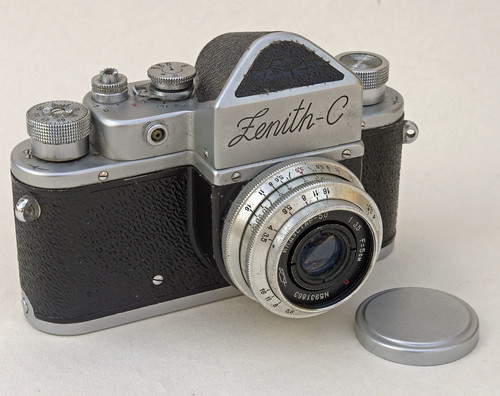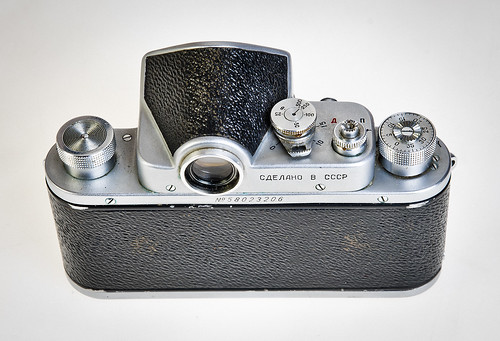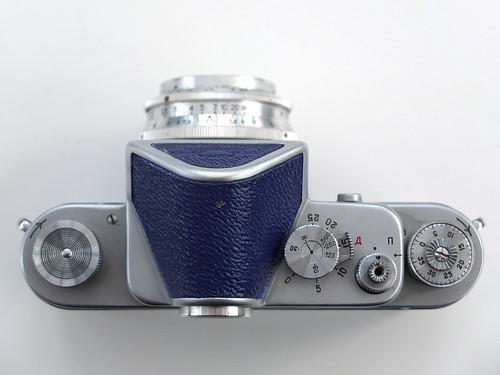Zenit C

|
| Zenit C with Industar-50 and yellow filter image by old_cameras (Image rights) |
The Zenit C[1] is a compact all-mechanical 35 mm SLR camera made in the Soviet Union. It is the second model in the Zenit camera line, following only three years after the original Zenit 1. It was made by Krasnogorskii Mekhanicheskii Zavod (Krasnogorsk Mechanical Works) near Moscow, between 1955 and 1961.[2]
Description
Ultimately, the Zenit-C is an SLR based on the Leica II. The Soviets copied the Leica II before WWII, producing the FED 1 and eventually the Zorki 1. These were close Leica copies, comparable in performance to original Leicas. Later, various derivatives came to pass--the integrated rangefinder FED 2 and the flash-synchronized Zorki S--and, to the point, the Zorki-derived Zenit, with a very Leica-like shutter and body, but an early SLR prism and mirror. The Zenit C is the flash-synchronized update of the Zenit. While there is some distance between the Leica II and the Zenit C, there is recognizable anatomy in common, and the vagaries of loading the two cameras are, unfortunately, the same.
To wit, film is loaded by removing the base of the camera, (the back does not open). The film leader must be cut down, as there are mechanical intricacies that will chew up the film if standard, untrimmed 35mm film is loaded. Film advance is by knob, as on the Zenit 1 (and the Leica II). Rewind is also similar, but the film is released for rewind by depressing and rotating the collar around the shutter release button to point at 'B' (on the Zenit 1 and its predecessors, the rewind release is a separate, simple lever).
The camera's features are, of course, very similar to those of the Zenit 1. The most important change is the addition of the flash synchronisation via a PC socket on the front of the top superstructure. The synchronisation delay is variable between zero (X-synch.) and 25 milliseconds (M-synch.) with a control under the shutter speed selector. There is no accessory shoe; any flash would have to be mounted on a bracket.
Another difference, not obvious to the user, is the use of a cord to pull the mirror down into position during film advance/shutter cocking, replacing a metal arm which does this job in the Zenit 1[3].
The shutter speed selector is also very slightly different: whereas on the earlier model, the whole selector is rotated to align the desired speed with a mark on the superstructure, on the Zenit C the mark is on the central axis of the selector.

|
| Zenith C for export, with name in Latin script (and with an 'h') image by Dave Dockerill (Image rights) |
Shutter
The shutter is absolutely typical of early focal-plane shutters, especially Russian shutters in this camera's lineage. It is a cloth-curtain shutter without a slow-speed timer.
It is absolutely imperative, despite anything that has been circulated to the contrary, and despite the absence of such a warning in the manual, that the shutter speed dial is only adjusted when cocked. If it is adjusted when the shutter is uncocked, there is a chance of severe damage to the speed assembly, probably irreparable at this point in time--the shutter will be ruined. Like the FED 2, there was some attempt made to fix this problem in the production of the Zenit C, but the problem is inherent to the design of the speed assembly and whatever solution was arrived at is unreliable and the chance of damage is still there. This is to be held as common to all Russian focal-plane shutters whether based on Leica, Contax, or anything else, unless it is definitively known not to be the case.
Lenses
The Zenit C can use the same (rather limited) range of 39 mm screw-mounted lenses as the other early Zenits. The standard lens is either a rigid-bodied 5 cm f/3.5 Industar-22 or the similar Industar-50 which replaced it from about 1959. Both are coated Tessar-type lenses (Industar is the Soviet name for this design). Neither of them have preset aperture rings, clickstops, or any other such conveniences. The aperture can only be set by taking the camera away from your eye, setting it, and then composing the picture. There is a noted problem on the Industar-50, at least, in which turning the aperture ring can disturb the focus ring, thus making it difficult to stop down after focusing.

|
| image by SBA73 (Image rights) |

|
| Zenit C with I-50 (fitted), Mir-1 wide-angle lens, extension tubes, case, instructions and box. image by Siim Vahur (Image rights) |
Conclusion
In a sense, most 35mm SLR's owed at least something to the Barnack Leica--the basic design of the self-capping focal-plane shutter did first come to fruition in the Leica I. And indeed, many SLR's were designed with vaguely Leica-like features: the Praktiflex and the Rectaflex, for instance. But more than either of those cameras, the early Zenits were derived directly from a Leica design lineage, and in a way they may be seen as the true SLR version of the Barnack Leica--albeit one produced much later and in a different country.
Specifications
- Type: 35 mm single-lens reflex camera
- Format: 24x36 mm on standard 135 cartridge film
- Manufacturer: KMZ
- Years of production: 1955-61
- Number produced: Est. 232, 949[4]
- Standard lens: Industar-50 1:3.5 F=5 cm
- Shutter:
- Cloth focal-plane shutter. 1/25 - 1/500 second plus 'B' on early examples; 1/30 - 1/500 second plus 'B' later. Cable release socket in shutter release button. No delayed action.
- Flash synchronisation by PC socket. Variable synchronisation delay, 0-25 ms.
- Viewfinder: Pentaprism viewfinder with ground glass focusing screen. No prismatic focusing aids.
- Dimensions (width x depth x height): 140 x 50 x 90 mm (body only).

|
| Top view. This example has the later shutter speed range image by Tony Kemplen (Image rights) |
Notes
- ↑ The 'C' is a Cyrillic 'S', and refers to the shutter's being synchronised for flash. However, even when in Latin script, the name is marked on the camera as 'Zenith C'.
- ↑ McKeown, James M. and Joan C. McKeown's Price Guide to Antique and Classic Cameras, 12th Edition, 2005-2006. USA, Centennial Photo Service, 2004. ISBN 0-931838-40-1 (hardcover). ISBN 0-931838-41-X (softcover). p. 553.
- ↑ The page on the Zenit 1 'camera line' (in Russian) formerly at the KMZ Archive (http://www.zenitcamera.com) and archived at the Internet Archive 'Wayback Machine' in December 2008, states only that the metal-arm mechanism was 'not very successful'.
- ↑ Production figures formerly shown at the KMZ Archive, and archived at the Internet Archive 'Wayback Machine' in June 2006.